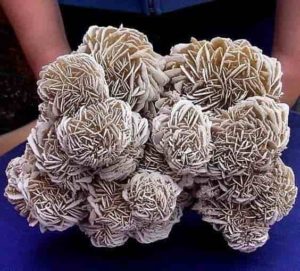
Desert Rose Rock
Desert rose is the colloquial name given to rose-like formations of gypsum or baryte crystal clusters which contain abundant grains of sand. The ‘petals’ are crystals flattened on the c crystallographic axis, fanning open in radiating flattened crystal clusters.
The rosette crystal habit tends to occur when the crystals form under arid sandy conditions, such as a shallow salt basin becoming evaporated. The crystals form a circular series of flat plates that give the rock a similar shape to a rose blossom.
How Do Desert Rose Rock Form?
Gypsum roses tend to have sharper edges better defined than baryt roses. Celestine and other minerals bladed with evaporite may also form clusters of rosettes. These can either appear as a single rose-like bloom, or as bloom clusters, with most sizes ranging from pea size to 4 inches (10 cm) in diameter.
The ambient sand that is incorporated into the crystal structure, or otherwise encrusts the crystals, varies with the local environment. If iron oxides are present, the rosettes take on a rusty tone.
The desert rose may also be known by the names: sand rose, rose rock, selenite rose, gypsum rose and baryte (barite) rose.
Where to find desert rose rock ?
Rose rocks are found in Tunisia, Libya, Morocco, Algeria, Jordan, Saudi Arabia, Qatar, Egypt, the United Arab Emirates, Spain (Fuerteventura, Canary Islands; Canet de Mar, Catalonia; La Almarcha, Cuenca), Mongolia (Gobi), Germany (Rockenberg), the United States (central Oklahoma; Cochise County, Arizona; Texas), Mexico (Ciudad Juárez, Chihuahua), Australia, South Africa and Namibia.
Desert Rose Rock Size
he average size of rose rocks are anywhere from 0.5 inches (1.3 cm) to 4 inches (10 cm) in diameter. The largest recorded by the Oklahoma Geological Survey was 17 inches (43 cm) across and 10 inches (25 cm) high, weighing 125 pounds (57 kg). Clusters of rose rocks up to 39 inches (99 cm) tall and weighing more than 1,000 pounds (454 kg) have been found.










